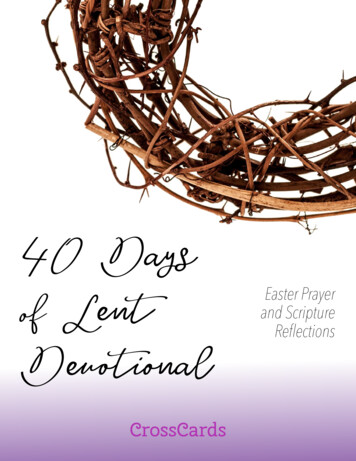![December 31 [The Last Day Of] The Old Year And What A](/img/40/paro-almanac-r.jpg)
Transcription
December 31 [The last day of] the old year and what a happy happyyear to us it has been; Oh! What will /64 bring to us!Diary of Margaret Gray Lord, 1863 (Acc 3466/HF78.63.1)The Public Archives and Records Office would like to acknowledgethe financial support of PEI 2014 Inc. in the creation of thiscommemorative almanac.Thank you to Robertson Library, University of Prince Edward Island, forallowing us to use their digitized copy of Meacham’s 1880 Atlasfor the image on page 11.The advertisements that appear at the front and back of the almanac arefrom Hutchinson’s Prince Edward Island Directory for 1864(Acc 4064/1a).Inspiration for the cover art was taken from Harvie’s 1872 Almanac(Acc 4225/s7/8).Research and Text by Gillian BookerPublic Archives and Records Office, PO Box 1000,Charlottetown, PE C1A 7M4www.gov.pe.ca/archives archives@gov.pe.caThe Public Archives 2014 Almanac and Miscellany Celebrating 1864:A Look at Prince Edward Island in the Year of the CharlottetownConference2014Design and Printing: Communications PEI13CU41-38151
About this AlmanacAn almanac is an annual calendar containing important dates andstatistical information such as astronomical data and tide tables.Some, like the familiar Old Farmer’s Almanac, contain informationspecific to a topic or pastime. Others contain more general interestinformation. Historically, almanacs were also used as daybooks ordiaries as they contained blank pages on which individuals couldrecord planting and harvest information, the comings and goings offamily members, important events in the community, comments onthe weather, and more. The almanac has even been compared tothe iPhone:“Just as an iPhone connects users to an outside world andprovides a feast of tools designed to make our lives easier, thealmanac held the same promise . Equipped with the latestissue, you always knew what day and time it was, how muchmoney you had, where you were going and how to get there. Asa bonus, you also could rely on your almanac for something toread along the way. Who could ask for anything more?”1This commemorative almanac was designed to celebrate PrinceEdward Island in 1864. Every month explores a different theme inIsland life from the time period. A list of “Remarkable Days” can befound at the beginning of each month, as well as photographs, maps,letters, diaries, newspaper clippings, and other records from thePublic Archives’ collection. Those traditional blank pages have alsobeen included, with sections specifically set aside for the recording ofthoughts and notes about 2014 celebratory events.Like the almanacs that came before, this commemorative almanac ismeant to be personalized and used, studied and consulted. We hopeyou find yourself picking up The Public Archives 2014 Almanac andMiscellany throughout 2014, and for many years to come.1Molly McCarthy, “Redeeming the Almanac: Learning to Appreciate the iPhone ofEarly America,” Common-Place, Vol. 11, No. 1, October 2010; http://www.common-place.org/vol-11/no-01/reading/.
JanuaryRemarkable DaysThe Levee at Government House on New Year’s Day was very numerouslyand respectably attended. After paying their respects to His Excellency,the visitors were received very kindly and with her accustomed grace andaffability, by Mrs. Dundas, in the drawing-room. The Monitor, Thursday, 7th January, 1864.After several days’ delay, the Couriers, with the mails, managed to crossto Cape Tormentine, on Monday last at noon. Among the passengers whowere compelled to wait some days for a favorable opportunity to cross, werethe Hon. James C. Pope, I. C. Hall and son, and Messrs. Van Horn, Atwoodand Hewes. Ross’s Weekly, Thursday, 7th January, 1864.The Government have offered a reward of 100 to any person or persons(not being an actual party to the act) who will give such information as willlead to the discovery, apprehension, and conviction of the person or personswho brutally murdered Terence MacInnis, late of Lot 66, farmer, on thenight of the 17th ult., - the perpetrators of the foul deed being still at large.A Reward of 50 has also been offered for the discovery of the parties who,on the night of the 30th of November last, sawed down the flagstaff of theAmerican Consulate, in the vicinity of Charlottetown. The Monitor, Thursday, 7th January, 1864.We learn that a little girl about five years of age, daughter of a Mr. Williams,residing in the Western part of this City, died on Wednesday morning fromthe effects of a severe burning, occasioned by playing with Lucifer matcheson Tuesday last. The Protestant and Evangelical Witness, Saturday, 9th January, 1864.12[th]. [B]ought a load of hay and a buffaloe for the sleigh. Diary of Sarah Louisa Cundall, 12th January, 1864, Acc. 5131/6.Tuesday Jan. 12th . . . . In Ev[enin]g at Prince of Wales Tea. . . . Singing &music & addresses formed the amusements after Tea. A very full house &successful affair. Diary of H. J. Cundall, 12th January, 1864, Acc. 3466/HF72.139.4.The Public Archives 2014 Almanac and Miscellany1
Within the past ten days, several horses have been lost in the ice of ourdifferent rivers. On Wednesday night, the 6th inst., it being intensely cold,a horse and sleigh with two men fell through the ice on East River, andafter being in the water some twenty minutes, the men managed, by hardstruggling, to reach firm ice, but their horse was lost. They almost perishedbefore they reached a house on the nearest shore. Ross’s Weekly, Thursday, 14th January, 1864.Roderick McLeod, who has for many years been an inmate of the LunaticAsylum in the neighborhood of this city, died there on Monday last. McLeodwas one of the unfortunate sufferers in the celebrated Belfast riot, where hereceived a severe blow on the head from a bludgeon, producing insanity. The Monitor, Thursday, 21st January, 1864.A Bazaar in aid of the Volunteer Band was held in the Temperance Hallon Wednesday, and was a brilliant success. The Hall was very tastefullydecorated for the occasion. The tables were amply supplied with fancy anduseful articles in great variety, and the ladies who had charge of them werenever more zealous or, we believe, more successful in obtaining purchasersfor their beautiful and attractive wares. The Hall was crowded with thebeauty and fashion of the City throughout the day and evening. The Examiner, Monday, 25th January, 1864.On Sabbath last the new Kirk, on Brackley Point Road, was opened forDivine Worship. The services were held during the day and evening. Rev.Mr. McLean of Belfast preached the forenoon and afternoon sermons, Rev.T. Duncan that of the evening. The new Church is a comfortable place ofworship. Ross’s Weekly, Thursday, 28th January, 1864.If the balance of the northern world can produce similar fine weather, andequally glorious sleighing, as the inhabitants of P. E. Island have enjoyedthus far, we should be pleased to hear of it. No severe storms have yet beenexperienced. . . . no rude wintry blasts disturbing the quiet alighting ofthe beautiful and tiny flakes, nor sweeping them madly hither and thither,blocking up streets, and doors and windows. Ross’s Weekly, Thursday, 28th January, 1864.On Saturday last, on Prince Street, Mrs. E. McCormack was run over by ahorse and sleigh, and somewhat badly injured. Ross’s Weekly, Thursday, 28th January, 1864.The Public Archives 2014 Almanac and Miscellany2
The Public Archives 2014 Almanac and Miscellany3
2014 Celebratory EventsThe Public Archives 2014 Almanac and Miscellany4
The Public Archives 2014 Almanac and Miscellany5
The Public Archives 2014 Almanac and Miscellany6
The Public Archives 2014 Almanac and Miscellany7
The Public Archives 2014 Almanac and Miscellany8
CharlottetownIn the 1860s, Charlottetown was a busy port with a successful ship-building industryand a vigorous network of trade. The incorporation of the city in 1855 began agradual process towards civic improvement and the institution of better services andfacilities. A range of businesses operated in Charlottetown at this time, providingboth locally-made products as well as items imported from Great Britain, the UnitedStates, and other parts of British North America. Grocery and hardware suppliers,furniture makers, shoe manufacturers, blacksmiths, and medical and legal serviceswere just some of the businesses that made up the commercial landscape of the city.Although the provision for public facilities had improved in Charlottetown by themid-1860s, with the introduction of gas lighting to the streets and the preparationof some planking for sidewalks, progress was gradual and the streets of the city atdifferent times of the year could still prove variously muddy and dusty. In August1864, Ross’s Weekly complained that Charlottetown had become ‘notorious for dust’and that goods and furniture had been rendered worthless due to the failure of the‘City Fathers’ to address the problem; while in November of the same year, thenewspaper spoke with envy of the new granite crossings that were to be laid at themuddiest corners in Halifax, wondering whether such a day would ever come toCharlottetown.Acc. 3252/69 Topographical Map of Prince Edward Islandin the Gulf of St. Lawrence, D. J. Lake, 1863.The Public Archives 2014 Almanac and Miscellany9
Acc. 3466/HF74.27.3.242 The Province Building, St. Paul’s Church andthe round Market House, Charlottetown, ca. 1860s.From the top of the Province Building there is a beautiful view; its peculiaritiesare strikingly American, and yet from the universal red clay roads, and banks ofthe rivers, it may claim its own native distinctions. Most visitors to a new city liketo get up on some high place and “view the landscape o’er,” and those who honorCharlottetown with their company may gratify this justifiable ambition by ascendingthe Province Building, and there from its summit attain many striking effects. In thissurvey will be seen buildings conspicuously placed highly indicative of the moral andreligious influence which its philanthropists and religious men exercise. Colleges,churches of every denomination, (among which the Catholic Cathedral standspre-eminent) Temperance Hall, Jail, the Barracks, two large Breweries, Gas Works,Steam Mills, and innumerable flagstaffs, ready for the gala bunting of any festival orjoyous occasion. Across the harbor, lie the village of Southport and the Blockhouse,and on its north bank, seen to great advantage on entering the harbor, GovernmentHouse, the present residence of His Excellency George Dundas, Esquire, LieutenantGovernor .Acc2353/538 The Progress and Prospects of Prince Edward Island by C. BirchBagster, 1861.The Public Archives 2014 Almanac and Miscellany10
Meacham’s Atlas of Prince Edward Island, 1880. Situated on the corner ofGreat George Street, the Union Bank opened to the public in June 1864, providingCharlottetown with its second financial institution, following the establishment ofthe Bank of Prince Edward Island a decade before.The Public Archives 2014 Almanac and Miscellany11
Queen Street is the main street, and slopes pleasantly to the water’s edge, terminatedby a fine wharf, and busy with shippers’ interests. The spirit of improvement has heresteadily worked and produced what in some respects may be called a fine street; thereis no feeling of confinement in it, and from its breadth, position and capabilities,it will some day be a very beautiful street; but Prince Street, parallel with QueenStreet, and separated from it by the length of Queen Square, is a pleasanter street,and when its freshly planted trees come to perfection, it will form a cool and shadedpromenade, having also a wharf to conduct to the saline waters of the Hillsborough,and place you where the summer breezes may refresh and invigorate, while thescenery delights and gratifies.Acc. 2353/538 The Progress and Prospects of Prince Edward Island by C. BirchBagster, 1861.Acc. 3218/10 Richmond St., Charlottetown, in winter, ca. 1862.The Public Archives 2014 Almanac and Miscellany12
Acc. 4064/1a Hutchinson’s Prince Edward Island Directory, 1864. Photographywas enjoying growing popularity in the 1860s. Several photographic studios operatedin Charlottetown at this time, affording residents the opportunity to sit for personalor family portraits.The Public Archives 2014 Almanac and Miscellany13
The Public Archives 2014 Almanac and Miscellany14RG16 Land Conveyance, Government to John G. Eckstadt, registered 1st December, 1865 [Liber 84, Folio 733]. The sale of themilitary barrack grounds in Charlottetown took place by auction in June 1864. The Examiner reported that ‘[g]reat care has been takento lay out the various sites in the most judicious manner, so as to combine the useful with the ornamental. A handsome esplanade, sixtyfeet wide on the entire sea face, has been reserved as a promenade and carriage drive for the beauty and fashion of the City, and thespot, which embraces one of the most enchanting and picturesque panoramas, bids fair to become the favorite resort of all’.
FebruaryRemarkable DaysSeveral boys were the other day brought up before the Mayor’s Court, andfined – one two pounds and others one pound each – for jumping on theback of sleighs passing through our streets. Ross’s Weekly, Thursday, 4th February, 1864.The young men in connection with the New London section of Rev.Alexander Cameron’s congregation, have presented their pastor with avery superior sleigh, together with a sum of money, as a token of esteem. Apleasing and encouraging address accompanied this free-will offering. The Protestant and Evangelical Witness, Saturday, 6th February, 1864.Mrs. Stevenson’s concert on Monday night was well attended . . . . Theprogramme consisted of English, Irish, and Scotch melodies, togetherwith selections from Italian and French composers. . . . We cannot avoidremarking that the splendid vocal powers of the talented lady who originatedand directed the concert were exhibited to great advantage in every piece. . . and her popularity cannot fail to have increased by this her secondappearance before a Charlottetown audience. The Vindicator, Wednesday, 10th February, 1864.The funeral of the late William Douse, Esq., was attended, on Mondaylast, by a very large number of people. The Free Masons (the deceasedhaving been a member of the Order) of the City were in attendance ina body; together with all the most respectable of our other citizens. Verymany of the Tenantry of the estates of which he was an Agent, followed theremains to the grave, thus testifying their respect for the deceased. We haveheard the funeral spoken of as being the largest that was ever seen beforein Charlottetown. Ross’s Weekly, Thursday, 11th February, 1864.Union Bank of P. E. Island. - A General Meeting of the Stockholders of thiscontemplated Bank took place . . . at the Colonial Building, on Thursdaylast, the 11th inst. The meeting was largely attended both by Town andCountry Stockholders. A series of carefully prepared By-laws, Rules andRegulations for the management of the affairs of the Corporation werepassed . . . . The Protestant and Evangelical Witness, Saturday, 13th February, 1864.The Public Archives 2014 Almanac and Miscellany15
Young Men’s Christian Association and Literary Institute. - Last Thursdayevening the Association was treated with “Sketches of Travel” by CharlesPalmer, Esq., and Dissolving-View exhibitions of the ascent of Mont Blanc,and some other interesting scenes in Europe. Mr. Palmer first referred toocean life on board the Atlantic steamers, then described some of the citiesand scenery of Ireland – among the latter the lakes of Killarney - thenconveyed his auditors over the channel to Holyhead . . . ; then to London- the building, extent and bustle of which he dwelt on for a considerabletime – and then he hied off to Paris – amid the splendid palaces of whichhe was stopped short in order to make time for the Dissolving-view part ofthe entertainment. . . . The exhibition of Dissolving views, which was underthe management of H. J. Cundall, Esq., was quite a success; seldom, if ever,have we seen views shown to better advantage. The Protestant and Evangelical Witness, Saturday, 13th February, 1864.Thur. 18[th]. Bright but drifting. The Western mail set out, but was obligedto return – the roads so much blocked up. Diary of Sarah Louisa Cundall, 18th February, 1864, Acc. 5131/6.The store of James DesBrisay & Co., dry goods’ merchants, was forciblyentered on the night of Friday last, through a back window, and coppersto the amount of 2 11s. 6d., together with homespun cloth purses, combs&c., were stolen. To effect an entrance the thief or thieves cut away part ofthe lower sash, and removed two panes of glass. On Saturday a boy namedJohn Fennessay, about 18 years of age, said to belong at Tignish . . . wasarrested for the burglary. . . . The bearing of Fennessay before the courtshowed him to be a hardened young scamp. Ross’s Weekly, Thursday, 18th February, 1864.For a week past we have had several falls of snow, but the first real snowstorm of the Winter occurred on Tuesday night, when nearly a foot of snowfell on the level, and on Wednesday it was knocked by the high wind intofantastic heaps, blocking up the roads in all directions. Ross’s Weekly, Thursday, 18th February, 1864.Has anyone about here seen the Comet! – Astronomers on both sides ofthe Atlantic tell us that Rhspighis’ Comet, commonly known as the cometof 1810, is adrift in the boundless expanse of the heavens, and on the 1st ofthe present month was to have approached to within the extremely shortdistance of eighteen millions of miles of the earth! It was not so far off but thatsome one must surely have seen it with the naked eye! Ross’s Weekly, Thursday, 18th February, 1864.The Public Archives 2014 Almanac and Miscellany16
The Public Archives 2014 Almanac and Miscellany17
2014 Celebratory EventsThe Public Archives 2014 Almanac and Miscellany18
The Public Archives 2014 Almanac and Miscellany19
The Public Archives 2014 Almanac and Miscellany20
The Public Archives 2014 Almanac and Miscellany21
The Public Archives 2014 Almanac and Miscellany22
Rural LifeAcc. 3466/HF74.27.3.7 A rural road in Prince Edward Island, 1861.The rural landscape of Prince Edward Island during the 1860s showed manysigns of development, with churches and schools the most obvious indicationsof community life; while in other more widely-settled rural areas businesses suchas general stores, tanneries, mills, and blacksmithing establishments also existed.Farms typically consisted of a hundred acres of land and a variety of food was grown,reared, and processed on them. Meat, such as beef and pork, was cured at home;crops, like wheat, potatoes, and turnips, were cultivated; and a selection of fruitswere produced and preserved. The self-sufficiency of the farm and the adequacyof its provisions were important, especially during the winter months, when ruralroads could be difficult to negotiate, and access to alternative food supplies couldprove challenging. The operation of the farm typically required the assistance ofthe whole family. While male members of the family undertook much of the heavylabour, like ploughing and hauling, women were involved in a variety of tasks thathelped to keep the farm running efficiently, from churning butter and cultivatingfruits and vegetables to raising poultry, collecting eggs, and making bread and otherhomemade produce. Children contributed to the work of the farm from an early age,partly as a source of additional labour, and partly to prepare the children for theirfuture when they would run farms and households of their own. Due to their relativeisolation, rural communities relied heavily on the mutual support of their residents,and exchanges of produce, dry goods, and labour between neighbours helped tosupport and promote the success and self-sufficiency of the community as a whole.The Public Archives 2014 Almanac and Miscellany23
Acc. 2540/1 Diary of Emma Stretch, 1st-5th May, 1860. Stretch’s diary for ca.1850-1860 records some of the typical tasks undertaken by family members in themanagement of a successful farm. It also demonstrates the close-knit community inwhich the farm operated showing, in particular, the mutual exchange of goods andlabour and the role Stretch played in managing such aspects of household economy.The Public Archives 2014 Almanac and Miscellany24
RG3/s2/ss1 Acts of the General Assembly of Prince Edward Island,1864. By the 1860s, some species of animals on Prince Edward Island had becomerare or had disappeared altogether through destruction of their habitat and overhunting. Caribou was extinct on the Island at this time and numbers of otter andlynx were also small. Bears still existed but were hunted, particularly for the dangerthat they posed to residents and for their attacks on livestock. The government’sconcern in 1864 for the dwindling number of partridge prompted it to take actionwith the passing of an act designed to facilitate the survival of the species on PrinceEdward Island.The Public Archives 2014 Almanac and Miscellany25
Acc. 4064/1a Hutchinson’s Prince Edward Island Directory, 1864.16th. Hay harvest very wet – employed machine to cut – don’t approve of itin bad weather – exposes too much grass at a time – several had their hayrotten before getting it in. Acc. 3466/HF83.74.1 Diary of David Ross, 16th June, 1864.The Public Archives 2014 Almanac and Miscellany26
Acc. 2353/93 Entry from 12th October, 1866, from the notebook of Islandnaturalist and farmer, Francis Bain.The Public Archives 2014 Almanac and Miscellany27
Acc. 2540/1 Practice composition written by Emmeline Stretch in the diary ofher mother Emma, 28th April, 1860, detailing her planned flower garden.“We were wont in childhood, to sow the seeds of certain flowers andvegetables in the shape of letters and words, so that our little gardensbecame legible and illuminated manuscripts as the spring wore on.” The Protestant and Evangelical Witness, Saturday, 3rd September, 1864.The Public Archives 2014 Almanac and Miscellany28
MarchRemarkable DaysThe removal of the old Church of St. Andrew’s Parish to Charlottetown, onthe ice, is worthy of more than a passing notice. The people of this Parishhaving completed their splendid new Church, and having no use for theold one, resolved on hauling it to the city for a school-house. . . . It is theoldest Catholic Church on the Island, having been built upwards of sixtyyears ago by Bishop McEachern. . . . To transport a Church upwards ofsixty feet in length, to a distance of twenty miles, was not an undertakingof a trifling nature. Hence, it was necessary, in the first place, to place thebuilding on a strong sleigh, the runners of which were of hard wood, at leasta foot square. The Church being securely fastened on to this sleigh, somefifty teams of horses were, on Monday, the 7th inst., tackled thereto, hauledit on to the ice of the Hillsboro’ River, and set out for Charlottetown. Alarge number of persons, Protestants as well as Catholics, assembled toaid in starting the Church; and seldom is there enjoyed anywhere a morebeautiful and picturesque sight than was enjoyed by those who witnessedthe Church passing down by Mount Stewart Bridge, at the rate of five milesan hour, accompanied as it was by hundreds of individuals. For about twelvemiles every thing went on admirably, and without even one stoppage; butwhen the building was approaching Apple-tree Wharf, and as the horseswere trotting along with the view of passing rapidly over the ice which wasknown to be weak at that place, suddenly the Church broke down into theriver. . . . After making several unsuccessful attempts to draw the buildingout of the ice, the people dispersed for the night. . . . On the following day . . [t]wo unsuccess-ful attempts were now made, and many were of opinionthat the building would never be got up. However, when the third effort wasmade, the Church issued forth from the hole. . . . On Wednesday morning . . [a] great portion of the city was in excitement, and many hundreds werecongregated along [Kent] street to witness the building going along as fastas the horses could walk. An immense crowd preceded and followed thebuilding, and the whole affair looked like a triumphal procession, as it reallywas . . . . When the Church reached Pownal Street, it was turned roundthe corner with as much apparent ease as an ordinary sleigh, and finallyplaced on the foundation prepared for it. . . . All the good people who tookan active part in the matter are deserving of much credit; but none aredeserving of more praise than the parishioners of St. Andrew’s, who . . . will,we hope, be amply rewarded for their zeal and piety, if not in this world, atall events in the world to come. The Vindicator, Wednesday, 16th March, 1864.The Public Archives 2014 Almanac and Miscellany29
Thunder was distinctly heard here on Saturday last, - rather an unusualphenomena at this season of the year. The Islander, Friday, 18th March, 1864.[T]he Nova Scotia Government intend submitting a resolution . . . for theappointment of delegates to confer with delegates from New Brunswickand Prince Edward Island, respectively, for the purpose of arrangingpreliminaries for the union of said colonies under one Government and oneLegislature, when such Union shall have been agreed to by the respectiveLegislatures, and confirmed by Her Majesty the Queen. The Protestant and Evangelical Witness, Saturday, 19th March, 1864.On Wednesday the 16th inst., Mr. George R. Mayhew, Tanner, of Margate,New London, discovered that his tan-vats, not very far from his dwellinghouse, had been opened, and some 200 worth of leather stolen. Theleather was ready for dressing. The thieves obliterated every trace of theiroperations, having returned the tan-bark to the vats and replaced thecovers. Mr. Mayhew thinks the robbery occurred about a fortnight previousto the time he discovered his loss. No trace of the perpetrators of the thefthas yet been discovered. Ross’s Weekly, Thursday, 24th March, 1864.24[th]. A heavy snow storm. [O]ne of the worst we have [had] this winter. Diary of Sarah Louisa Cundall, 24th March, 1864, Acc. 5131/6.Several very fine Fatted Cattle, the property of Mr. James Blake, Butcher, ofthis City, were exhibited on the market square on Tuesday last. Some primeEaster Beef may be expected in to-morrow’s market. The Islander, Friday, 25th March, 1864.On Monday the 21st inst., the stable of Mr. Wm. H. Botts, at Nine MileCreek, Lot 65, was burned, together with a horse, a valuable mare in foal,a cow, a heifer, a calf, and a pig. The horse belonged to a brother-in-law ofMr. Botts, who was visiting him; and it seems that while they were puttingup the horse, fire must have been communicated from the candle to some ofthe hay thrown to the horse, as the stable was seen to be in flames in a fewminutes after the parties attending the horse left. It was a heavy loss for Mr.Botts. He was lying at the time ill from injuries received a week previous, bybeing accidently trampled upon in the chest by a powerful horse. The Monitor, Thursday, 31st March, 1864.The Public Archives 2014 Almanac and Miscellany30
The Public Archives 2014 Almanac and Miscellany31
2014 Celebratory EventsThe Public Archives 2014 Almanac and Miscellany32
The Public Archives 2014 Almanac and Miscellany33
The Public Archives 2014 Almanac and Miscellany34
The Public Archives 2014 Almanac and Miscellany35
The Public Archives 2014 Almanac and Miscellany36
EducationAcc. 4158 St. Dunstan’s College, 1862, from the photograph album of H. J. Cundall.In 1852, the Free Education Act was passed in Prince Edward Island. Prior tothis Act, teachers’ salaries had been paid through local taxation in the district inwhich they taught. This practice frequently resulted in poor wages and unreliablepayments. Under the new Act, the government assumed responsibility for teachers’salaries as a means of encouraging more qualified teachers to take up employmentin Island schools. The free admittance to schools of children over five sawattendance double within the two years following the introduction of the Act. Thisdevelopment was particularly advantageous for the children of poorer families, whogained an opportunity to broaden their prospects through education. Despite thesepositive steps, the education system on the Island in the 1860s still encounteredmany problems. Attendance, though increased, was frequently sporadic, beinggreatly affected by the seasonal demands of agricultural life, whereby many olderchildren would stay home to assist with the farm during particularly busy times,like the harvest. In return for government assistance with teaching salaries, localcommunities were responsible for the financial cost of building and maintainingschools. Some schoolhouses were in good condition; while others were in urgentneed of repair. The very worst examples, the school inspector reported in 1863, were‘wretched hovels, so contracted in space and height, as to be injurious to the health’.In some cases, a lack of sufficient teaching resources, such as books, maps, andblackboards, also hindered instruction. The Free Education Act made schoolingon Prince Edward Island during the 1860s more accessible, but the quality of theeducation students received differed greatly according to several factors, includingthe availability of resources, the capabilities and determination of teachers, andthe importance placed by families on the attendance of their children in a noncompulsory system of education.The Public Archives 2014 Almanac and Miscellany37
Charlottetown Herald, 1st November, 1865.The three principal seats of higher education in the Island during the 1860s werelocated in Charlottetown: St. Dunstan’s C
Meacham's Atlas of Prince Edward Island, 1880. Situated on the corner of Great George Street, the Union Bank opened to the public in June 1864, providing Charlottetown with its second financial institution, following the establishment of the Bank of Prince Edward Island a decade before.



![Welcome [dashdiet.me]](/img/17/30-day-weight-loss-journal.jpg)







